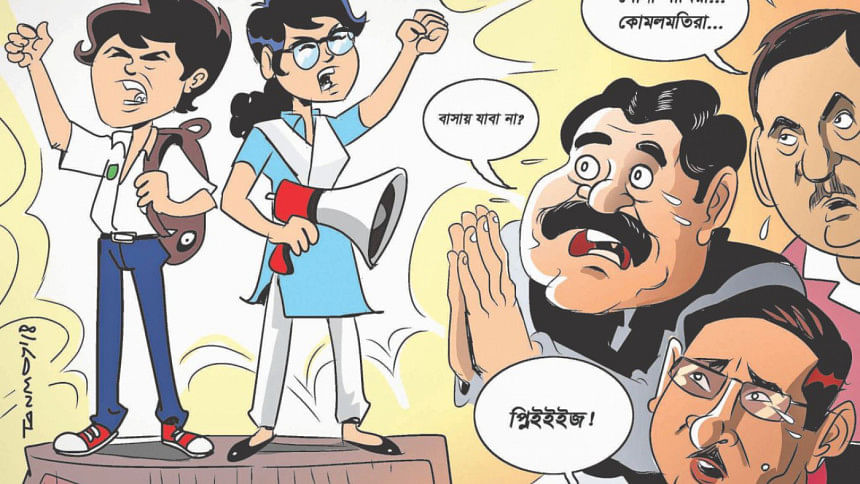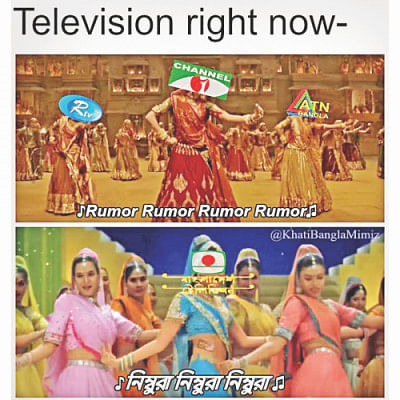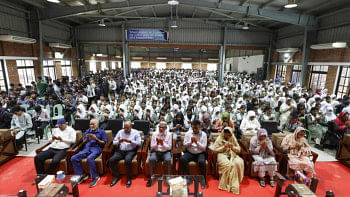Age of innocence - news discourse surrounding a students' movement

“They should have taken our demands seriously, but they didn't," Imran Ahmed, a protesting student, told Al Jazeera on August 3, the fifth day of mass student protests demanding safe roads.
This frustration was widely felt throughout the protesting student body, often labelled as komol moti kishor-koshori (naïve teenagers) by adults in power and in mainstream news channels. Many policymakers did not take them seriously at first, refusing to go down to the protests and hear them out. In several news channels, however, cabinet members did discuss the students—and it is interesting to observe how talk show hosts and policymakers chose to talk about these events developing throughout the week.
Earlier in the movement, when students were pressing onto their nine-point demand ensuring road safety, Shipping Minister Shajahan Khan, preferred using the term amar chhatro bondhura (my student friends) to refer to the protestors. His choice of words was gentle and approachable, hinting at possibilities of some sort of friendly alliance between the students and the minister who received majority of the backlash from the students for dismissively laughing at the tragedy of the student deaths. Yet his address did not suggest a complete acknowledgment of the student protestors as his equal—it resonated with the commonly used chotto bondhura (little friends), which contains a coaxing tone rather than genuine willingness to welcome dialogue. This sort of coaxing is usually applied when communicating to an audience significantly naïve, like in a magic show, or in Mustafa Monowar's children's programmes on BTV. Therefore, it is apparent that from the very beginning of the movement, politicians and news channels were speaking about the protestors as if they were infants.
The seeming infantilisation led to further assumptions being imposed on a very legitimate protest. Cabinet ministers and even television hosts adopted a rhetoric that the protests rose from an emotional standpoint, a result of childish wilfulness. While several ministers expressed solidarity with the cause, they still refused to engage in dialogue with the teenagers. Upon being questioned as to why during Ekattor TV's “Songbadjog” on the second day of protests, Home Minister Asaduzzaman Khan said, “these young children are hurt and upset, we understand that, and they are out on the streets to express that sadness. We do not oppose any of that, we feel that they will return home on their own terms once they are done expressing their sorrow”.
What this sort of comment does is seize agency from a protest that is rightful and just. Using adjectives such as “emotional” to repeatedly describe and address protests employs a traditional dichotomy that what is emotional, cannot be rational. Therefore, it almost frames the protests as irrational, stemming from the grief of teenagers. However, the student movement was anything but irrational—in fact, it is a legitimate resistance against a corrupt public transport system that continuously fails to ensure safety for its citizens.
The infantilised sentiment continued throughout the news discourse in most mainstream channels. A prominent female journalist hosted a talk show on the fourth day of the protests, where she repeatedly framed the students as “abegpurno (full of emotions)”. While speaking to a student protestor on the phone, she commented that “you are very concise for your age” as if someone in their late teens shouldn't have been able to articulate their thoughts in such a manner.
This linguistic rhetoric was effectively reducing these protestors to unthinking beings. This was in part possible because the protestors were actually young. So, using kishor-kishori, for example, is not exactly wrong. What is wrong, though, is thinking that kishor-kishoris are devoid of thinking abilities that can make dignified demands to the government. Inserting a sense of cognitive vulnerability when speaking about the teenaged protestors not only exhibits a mistrust in a generation of future nation builders, but also creates ambiguity towards the demands made by this group.
This sense of mistrust was further propagated when social media activity by the youth increased following the Saturday attacks on protestors in Jhigatola which media outlets were not able to properly report on. Several journalists were attacked whilst trying to obtain footage of what was happening, including journalists from print media. Ekattor TV was served a notice requesting them to be cautious of instigating “public disorder”. Furthermore, internet connection was slow and therefore, people were unable to see live videos from the scene. One could say that there was almost an absence of credible information during the 24 hours following the midday violence at Jhigatola, turning the internet into a cradle of conspiracies.

Once the confusion settled and media resumed reporting, the mistrust towards the youth's sense of judgment persisted. Ever since the cabinet minister and even the prime minister had declared solidarity with the cause of road safety, the common language used to refer to the protests was jouktik (rational). But there's a catch! The positive coining of the protest is entering the discourse when government officials are claiming that “vested quarters” are trying to seize the momentum of such a logical protest. This new “logical” essence, however, still assumes that teenagers are wildly prone to solicitation; that while their demand may have been logical, they themselves may not have a good sense of judgement since they fell for online rumours. After all, they are still children.
The prime minister, in her speech on August 6, while inaugurating fibre optics connection in 300 unions, referred to the protestors as shishu (children) who should be brought home by their guardians before any “third-party” harms them. From kishor-kishori to shishu, it seems that the cognitive agency of the protestor continues to slide down the age scale. The abstract intellect of the student protestors slowly proved to be a ground for political parties, on every end, to make a claim. The hot word, then, in the post-Saturday phase of the discourse became ushkani (instigation), according to a talk show host, who hosted an hour-long programme on fake news and instigation.
What was missing from the general talk show discussions on Sunday and Monday across most TV channels, were the repeated attacks by the police and other plainclothes men on university campuses across the capital. Of course, an exhaustive analysis is beyond the scope of this article, but it doesn't take much for one to grasp the general trend after scanning through a handful of prominent TV channels. DBC's talk show, “Rajkahon”, hosted by Nobonita Chowdhury, discussed legal barriers to improving the transport system while Ekattor TV's “Journal” was more concerned about traffic maintenance. Channel 24 centred their talk show “Muktobak” on August 6 around migrant rights.
Save for one segment in DBC news, “Shongbad Shomprosharon”, which spoke of the politicisation of the neutral student movement, news channels were more concerned about the new transport instead of the unlawful attacks on the students. The TV stations perused by yours truly were unable to host any prominent minister or ruling party spokesperson who could shed more light on the political turn this protest has taken. With this approach, perhaps the silence is what made these attacks appear political and created suspicion amongst television viewers across the country.
What I found most intriguing in the way we talk about this people's protest, at the time of writing this article, is the absence of testimonies from the ground. Beginning from the first phase of the protests on July 30, only a few student participations could be observed in the talk shows, especially in physical presence. The very youth which was adamantly vocal over social media, was left out during discussion in mainstream media. While social media is being antagonised for the spread of unverified news, it is worth realising that it gave a platform to voices on the ground which TV channels failed to incorporate in their news.
It is uncertain to me what new angle the discussion surrounding the protests would take by the time this article will be published. But I hope that talk show hosts, politicians, and policy makers, don't lose sight of their responsibility to the people—that whatever they choose to disclose or not disclose on mass media will have certain effects on people. Students can lose trust in what prominent personalities say on TV—and by extension, in the media, just as they did in policymakers. Just because the protestors are young, politicians and news hosts should not treat them with negligence. They must approach this apolitical movement with the dignity and agency that it deserves.
Disclaimer: For citation purposes, only segments available on TV channel's official YouTube were cited here.

 For all latest news, follow The Daily Star's Google News channel.
For all latest news, follow The Daily Star's Google News channel. 



Comments